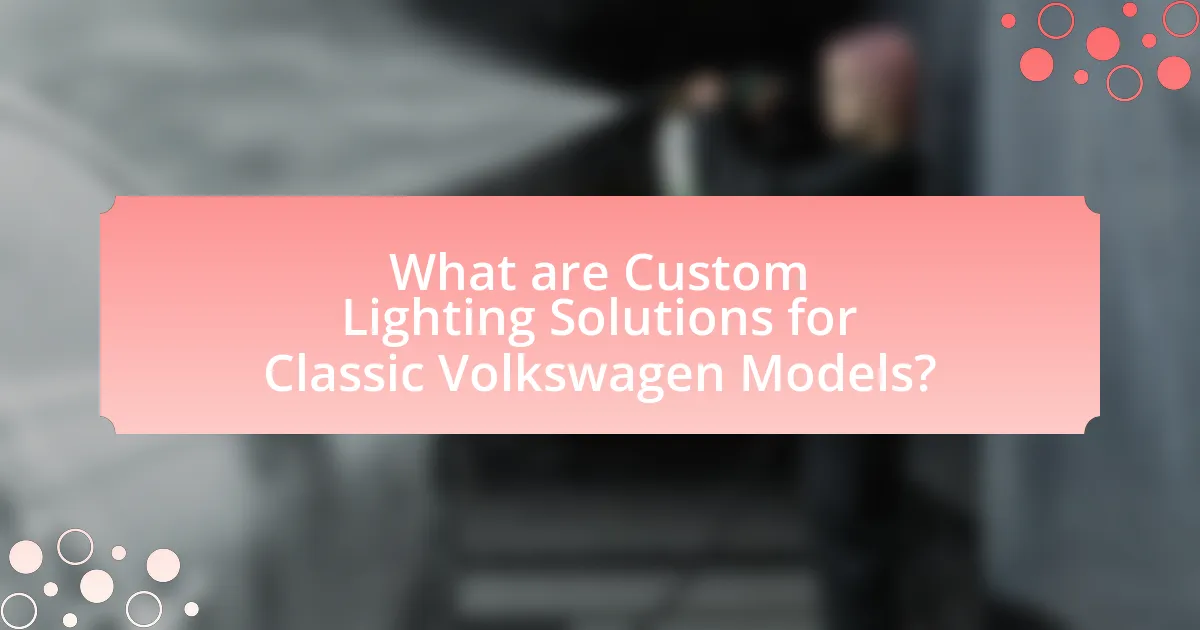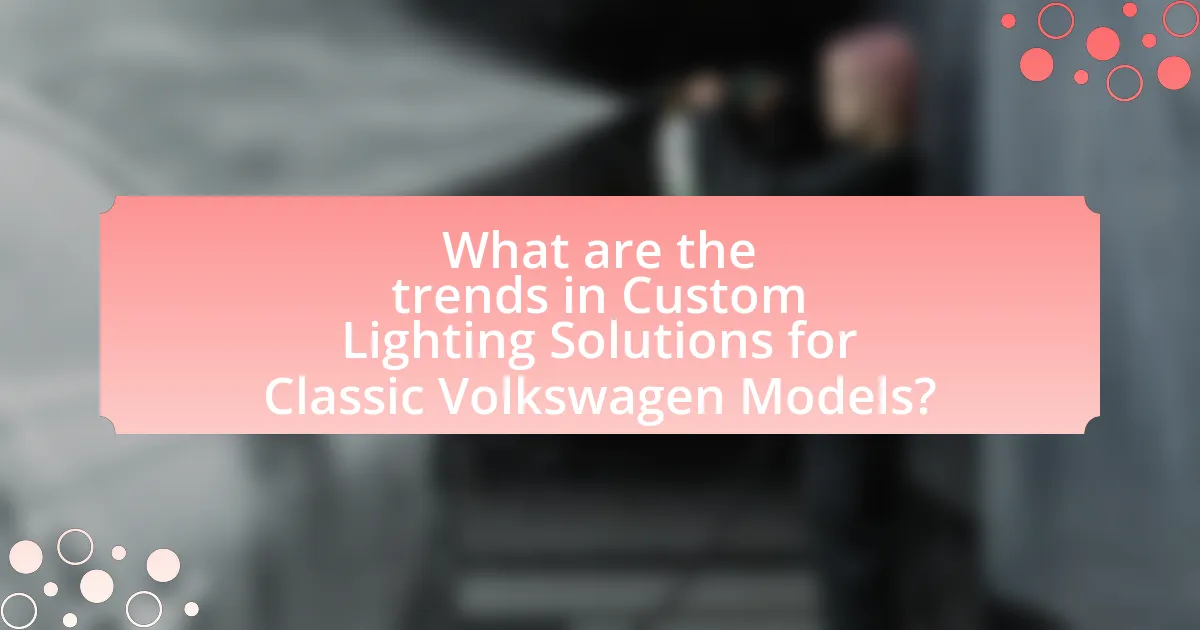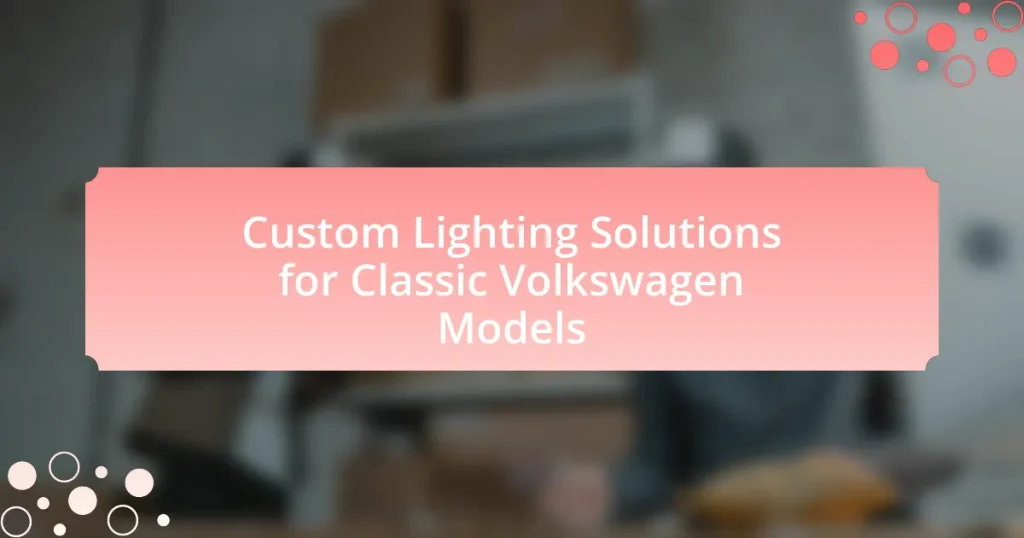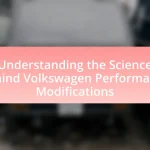Custom lighting solutions for classic Volkswagen models encompass specialized lighting options that enhance both aesthetics and functionality. These solutions include LED headlights, custom tail lights, and interior lighting kits, which improve visibility and modernize the vintage look of these vehicles. The article explores various types of lighting options available, their impact on the overall appearance of classic Volkswagens, and the importance of safety and compliance with regulations. Additionally, it addresses installation processes, common challenges, and trends in custom lighting, highlighting how modern technologies influence design while preserving vintage aesthetics.

What are Custom Lighting Solutions for Classic Volkswagen Models?
Custom lighting solutions for classic Volkswagen models refer to specialized lighting options designed to enhance both the aesthetic and functional aspects of these vehicles. These solutions often include LED headlights, custom tail lights, and interior lighting kits that improve visibility and modernize the classic look. For instance, LED headlights provide brighter illumination and longer lifespan compared to traditional halogen bulbs, making them a popular upgrade among enthusiasts. Additionally, custom tail lights can feature unique designs or colors that reflect the owner’s personal style while ensuring compliance with safety regulations.
How do Custom Lighting Solutions enhance the aesthetics of Classic Volkswagen Models?
Custom lighting solutions enhance the aesthetics of classic Volkswagen models by providing a modern touch that complements their vintage design. These tailored lighting options, such as LED headlights and ambient interior lighting, improve visibility while maintaining the classic look. For instance, LED technology offers a brighter, more energy-efficient alternative to traditional bulbs, allowing for a sleek appearance without compromising the vehicle’s original charm. Additionally, custom lighting can highlight specific design features of the car, such as the iconic curves and lines of models like the Beetle or Bus, thereby elevating their visual appeal.
What types of lighting options are available for Classic Volkswagen Models?
Classic Volkswagen models offer several lighting options, including halogen headlights, LED headlights, and vintage-style bulbs. Halogen headlights provide a bright, white light and are a common upgrade for improved visibility. LED headlights are energy-efficient and have a longer lifespan, making them a popular choice for modernizing classic vehicles. Vintage-style bulbs maintain the original aesthetic while providing adequate illumination. These options cater to both functionality and the preservation of the classic look, ensuring that owners can enhance their vehicles while staying true to their heritage.
How do different lighting styles impact the overall look of these vehicles?
Different lighting styles significantly enhance the overall look of classic Volkswagen vehicles by emphasizing their unique design features and creating distinct visual atmospheres. For instance, warm LED lights can accentuate the vintage curves and lines of models like the Volkswagen Beetle, giving it a nostalgic glow, while cooler, brighter lights can modernize the appearance, making the vehicle stand out in contemporary settings. Research indicates that the choice of lighting can alter perceptions of size and shape; for example, softer lighting can make a vehicle appear more inviting, while harsher lighting can create a more aggressive look. This adaptability in lighting styles allows owners to customize their classic Volkswagens to reflect personal aesthetics and preferences, ultimately enhancing the vehicle’s appeal and character.
Why are Custom Lighting Solutions important for Classic Volkswagen Models?
Custom lighting solutions are important for classic Volkswagen models because they enhance visibility and safety while preserving the vehicle’s aesthetic appeal. Classic Volkswagen models often lack modern lighting technology, which can lead to inadequate illumination on the road. By integrating custom lighting solutions, owners can improve nighttime visibility and ensure compliance with contemporary safety standards. Additionally, these solutions allow for personalization, enabling owners to maintain the vintage look while upgrading functionality. This balance of safety and style is crucial for classic car enthusiasts who wish to enjoy their vehicles without compromising on performance or appearance.
What safety benefits do upgraded lighting systems provide?
Upgraded lighting systems enhance safety by improving visibility for drivers and pedestrians. Enhanced brightness and clarity reduce the likelihood of accidents, as studies indicate that well-lit environments can decrease nighttime crash rates by up to 30%. Additionally, modern lighting technologies, such as LED and adaptive lighting, provide better illumination of road signs and obstacles, further contributing to safer driving conditions.
How can custom lighting improve visibility during night driving?
Custom lighting significantly enhances visibility during night driving by providing tailored illumination that meets specific driving conditions. For instance, LED headlights can produce a brighter and more focused beam compared to standard halogen lights, allowing drivers to see further down the road and detect obstacles sooner. Research indicates that well-designed lighting systems can improve visibility by up to 200% compared to traditional lighting, reducing the likelihood of accidents at night. Additionally, custom lighting solutions can include features like adaptive lighting, which adjusts the beam angle based on steering input, further improving visibility in curves and turns.
What factors should be considered when choosing Custom Lighting Solutions?
When choosing custom lighting solutions, factors such as compatibility, design aesthetics, brightness, energy efficiency, and installation requirements must be considered. Compatibility ensures that the lighting fits the specific model of the classic Volkswagen, as different models may have unique electrical systems and mounting points. Design aesthetics are crucial for maintaining the vintage look while incorporating modern lighting technology. Brightness levels should meet safety standards and enhance visibility without being overly harsh. Energy efficiency is important for reducing power consumption, especially in older vehicles with limited electrical capacity. Lastly, installation requirements should be evaluated to determine if professional assistance is needed or if the installation can be done by the owner, which can affect overall costs and convenience.
How does the choice of materials affect lighting performance?
The choice of materials significantly affects lighting performance by influencing light transmission, diffusion, and heat dissipation. For instance, materials like polycarbonate and glass have different refractive indices, which can alter the intensity and quality of light emitted from a fixture. Polycarbonate is lightweight and impact-resistant, making it suitable for automotive applications, while glass offers superior clarity and scratch resistance, enhancing light output. Additionally, reflective materials used in light housings can improve efficiency by directing more light forward, thus optimizing visibility. Studies have shown that using high-quality materials can increase the lumen output by up to 30%, demonstrating the critical role material selection plays in achieving effective lighting solutions for classic Volkswagen models.
What are the legal considerations for custom lighting on Classic Volkswagen Models?
Custom lighting on Classic Volkswagen models must comply with local vehicle regulations, which often dictate the types of lights allowed, their colors, and their placement. For instance, many jurisdictions prohibit the use of certain colors, such as blue or red, for non-emergency vehicles, as these colors are typically reserved for law enforcement. Additionally, modifications must not obstruct visibility or distract other drivers, adhering to safety standards set by organizations like the National Highway Traffic Safety Administration (NHTSA). Furthermore, any custom lighting must be properly installed to avoid electrical issues or hazards, which could lead to legal liabilities.

How can Custom Lighting Solutions be installed in Classic Volkswagen Models?
Custom lighting solutions can be installed in classic Volkswagen models by replacing the existing bulbs with LED or custom-designed fixtures that fit the original housings. This process typically involves removing the headlight or taillight assemblies, disconnecting the old bulbs, and connecting the new lighting components, ensuring compatibility with the vehicle’s electrical system. Proper installation may require the use of adapters or wiring modifications to accommodate the new lighting technology, which is often more energy-efficient and provides better illumination.
What tools and materials are needed for installation?
For the installation of custom lighting solutions for classic Volkswagen models, essential tools and materials include a screwdriver set, wire strippers, electrical tape, soldering iron, and heat shrink tubing. These tools facilitate the removal of existing fixtures, proper wiring, and secure connections. Additionally, materials such as LED light strips or bulbs, mounting brackets, and connectors are necessary to complete the installation effectively. The use of these specific tools and materials ensures a safe and efficient installation process, aligning with industry standards for automotive lighting modifications.
How do you prepare a Classic Volkswagen Model for lighting installation?
To prepare a Classic Volkswagen Model for lighting installation, first, disconnect the vehicle’s battery to ensure safety during the process. This step prevents any electrical shorts or shocks while working on the lighting system. Next, remove any existing light fixtures or components that will be replaced or upgraded, which may involve unscrewing or unclipping them from their mounts. After that, clean the mounting surfaces to ensure proper adhesion and fit for the new lighting components. Finally, plan the wiring route for the new lights, ensuring it avoids any moving parts and is secured properly to prevent wear or damage. This preparation is crucial for a successful and safe lighting installation.
What are the step-by-step instructions for installing custom lights?
To install custom lights on classic Volkswagen models, follow these step-by-step instructions:
- Gather necessary tools and materials, including custom lights, wiring harness, connectors, electrical tape, and a screwdriver.
- Disconnect the vehicle’s battery to ensure safety during installation.
- Remove the existing light fixtures by unscrewing them from their mounts.
- Carefully disconnect the wiring from the old lights, noting the color codes for proper reconnection.
- Connect the wiring harness of the custom lights to the vehicle’s wiring, matching the color codes.
- Secure the connections with connectors and wrap them with electrical tape to prevent exposure.
- Mount the custom lights in the desired location, ensuring they are securely fastened.
- Reconnect the vehicle’s battery and test the lights to ensure they function correctly.
These instructions are based on standard practices for automotive lighting installation, ensuring compatibility and safety.
What common challenges might arise during installation?
Common challenges during the installation of custom lighting solutions for classic Volkswagen models include compatibility issues, wiring complexities, and securing proper mounting. Compatibility issues arise when new lighting components do not fit existing fixtures or electrical systems, which can lead to functionality problems. Wiring complexities often occur due to the age of the vehicle’s electrical system, requiring modifications or additional components to ensure proper connections. Securing proper mounting can be challenging as custom solutions may not align with original mounting points, necessitating fabrication or adjustments to the vehicle’s structure. These challenges are frequently encountered by enthusiasts and professionals alike, highlighting the need for careful planning and expertise during installation.
How can wiring issues be resolved during the installation process?
Wiring issues during the installation process can be resolved by systematically checking connections, ensuring proper wire gauge, and using quality connectors. First, verifying that all connections are secure and correctly matched to their corresponding components prevents loose or faulty connections. Second, selecting the appropriate wire gauge based on the electrical load ensures that the wiring can handle the current without overheating, which is crucial for safety and functionality. Lastly, utilizing high-quality connectors minimizes the risk of corrosion and ensures a reliable electrical connection. These steps are essential for achieving a successful installation of custom lighting solutions in classic Volkswagen models.
What troubleshooting tips can help ensure a successful installation?
To ensure a successful installation of custom lighting solutions for classic Volkswagen models, verify compatibility with the vehicle’s electrical system. This includes checking voltage requirements and ensuring that the wiring harness matches the specifications of the lighting components. Additionally, inspect all connections for corrosion or damage, as these can lead to poor performance or failure. Following the manufacturer’s installation instructions meticulously is crucial, as they provide specific guidance tailored to the product. Finally, testing the system before finalizing the installation can help identify any issues early, ensuring that all lights function correctly and safely.

What are the trends in Custom Lighting Solutions for Classic Volkswagen Models?
Trends in custom lighting solutions for classic Volkswagen models include the increasing popularity of LED technology, which offers enhanced brightness and energy efficiency compared to traditional incandescent bulbs. Additionally, there is a growing demand for retrofitted lighting designs that maintain the vintage aesthetic while incorporating modern functionality, such as customizable color options and integrated turn signals. Furthermore, the use of projector headlights is becoming more common, providing improved visibility and a distinctive look. These trends reflect a broader movement towards personalization and modernization in the classic car restoration community, as enthusiasts seek to blend classic design with contemporary technology.
How are modern technologies influencing custom lighting designs?
Modern technologies are significantly influencing custom lighting designs by enabling advanced features such as smart controls, energy efficiency, and innovative materials. Smart lighting systems, which can be controlled via mobile apps or voice commands, allow users to customize brightness, color, and timing, enhancing the user experience. Additionally, LED technology has revolutionized lighting by providing longer lifespans and lower energy consumption compared to traditional bulbs, making custom designs more sustainable. Furthermore, advancements in 3D printing and flexible materials allow for unique shapes and designs that were previously difficult to achieve, enabling greater creativity in custom lighting solutions for classic Volkswagen models.
What role do LED lights play in contemporary custom lighting solutions?
LED lights serve a crucial role in contemporary custom lighting solutions by providing energy efficiency, versatility, and enhanced aesthetic appeal. These lights consume significantly less energy compared to traditional incandescent bulbs, often using up to 80% less energy, which contributes to lower operational costs and reduced environmental impact. Additionally, LED technology allows for a wide range of color temperatures and designs, enabling customization that aligns with the unique styles of classic Volkswagen models. The longevity of LED lights, with lifespans often exceeding 25,000 hours, further supports their use in custom applications, minimizing the need for frequent replacements and maintenance.
How are vintage aesthetics being preserved in modern lighting designs?
Vintage aesthetics are preserved in modern lighting designs through the use of retro-inspired materials, shapes, and technologies that evoke the classic styles of earlier decades. Designers often incorporate elements such as warm-toned LED bulbs that mimic the glow of incandescent lights, as well as fixtures that feature vintage motifs like Edison bulbs and antique finishes. For instance, the integration of these design elements in custom lighting solutions for classic Volkswagen models ensures that the modern enhancements do not detract from the vehicle’s original charm, maintaining a cohesive aesthetic that appeals to enthusiasts. This approach not only honors the historical significance of vintage designs but also meets contemporary standards for energy efficiency and functionality.
What are the most popular custom lighting modifications among enthusiasts?
The most popular custom lighting modifications among enthusiasts include LED headlight conversions, custom tail lights, and underglow lighting. LED headlight conversions enhance visibility and modernize the appearance of classic Volkswagen models, while custom tail lights allow for personalized designs and improved safety through brighter illumination. Underglow lighting adds a unique aesthetic appeal, often used for show cars, and can be synchronized with music for dynamic effects. These modifications are favored for their combination of functionality and style, making them essential upgrades for enthusiasts looking to enhance their vehicles.
Which lighting upgrades are considered must-haves for Classic Volkswagen Models?
Must-have lighting upgrades for Classic Volkswagen Models include LED headlights, which provide brighter illumination and improved visibility compared to traditional halogen bulbs. Additionally, installing LED taillights enhances safety by increasing visibility to other drivers. Upgrading to a modern wiring harness can also support these new lighting systems, ensuring optimal performance and reliability. These upgrades are essential for enhancing both the aesthetic appeal and safety of Classic Volkswagen vehicles.
How do community preferences shape the future of custom lighting solutions?
Community preferences significantly influence the future of custom lighting solutions by driving demand for specific styles, functionalities, and technologies. As enthusiasts of classic Volkswagen models express their desires for unique lighting designs that enhance aesthetics and improve visibility, manufacturers adapt their offerings to meet these expectations. For instance, the rise in popularity of LED technology among community members has led to increased production of LED-based custom lighting kits, which are now favored for their energy efficiency and longevity. Additionally, community feedback on design trends, such as retro aesthetics or modern integrations, shapes product development, ensuring that new lighting solutions resonate with consumer tastes and enhance the overall ownership experience of classic vehicles.
What are the best practices for maintaining Custom Lighting Solutions in Classic Volkswagen Models?
The best practices for maintaining custom lighting solutions in classic Volkswagen models include regular inspections, proper cleaning, and ensuring secure connections. Regular inspections help identify any signs of wear or damage, which is crucial for maintaining functionality and safety. Cleaning the lenses and fixtures prevents dirt and grime buildup that can diminish light output, while ensuring secure connections prevents electrical issues that could lead to failures. Additionally, using high-quality components designed for classic vehicles enhances durability and performance, as evidenced by the fact that many enthusiasts report improved reliability when using specialized aftermarket parts.


